カマキリ-クイックガイド
Mantis Bug Trackerは、オープンソースのWebベースのアプリケーションツールです。欠陥ライフサイクル全体のバグ追跡に使用されます。Mantisは、バグ追跡に加えて、プロジェクトまたはソフトウェアのさまざまなリリースを管理するためのリリース機能をサポートしています。
MantisはMantisBTとも呼ばれ、Mantis BugTrackerの略です。カマキリの名前とロゴは、カマキリ科の昆虫を指しています。ソフトウェアでは、バグと呼ばれます。
Mantisは、ツールのデモ、ダウンロード(独自のMantisをセットアップするため)、およびホスティングバージョンを提供します。リリース管理とともに、問題追跡とライフサイクルのさまざまな機能をサポートします。
マンティスの開発は2000年に伊藤健三郎によって始まりました。2002年後半、他のチームメンバー(Jeroen Latour、Victor Boctor、Julian Fitzell)が参加しました。Mantisの基本バージョン1.0.0は2006年2月にリリースされました。
2012年、GitHubはMantisプロジェクトのソースコードの公式リポジトリになりました。
ライセンスと無料トライアル
オープンソースソフトウェアです。基本バージョンを使用するためにライセンスは必要ありません。
無料のトレイルのデモとホスティングバージョンを提供します。
独自のMantisソフトウェアをセットアップするためのダウンロード機能をサポートしています。ユーザーはメールIDを使用してサインアップできます。
Mantisには、で見ることができる追加機能に基づいて異なる価格見積もりがあります https://www.mantishub.com/pricing
使用法
欠陥のライフサイクル全体ですべてのバグ/問題を追跡します。
リリースレベルでも管理します。
分析およびレポート機能をサポートします。
他のソフトウェアやIDEとのプラグインをサポートして、より強力で効果的なものにします。
仕様
| シニア番号 | 仕様と説明 |
|---|---|
| 1 | Application Copyright 著作権はMANTISSystem Limited Company(「MANTISSYSTEM」)が所有します。 ライセンスはGNUGeneral PublicLicenseバージョン2で取得されます |
| 2 | Tool Scope バグ追跡システムとして使用できます |
| 3 | Stable Release 2.1.0以降。最新リリースは2.5.1です |
| 4 | Developed Language コーディング言語としてのPHPとデータベース用のSQL ツールは49の言語をサポートします |
| 5 | Operating System クロスプラットフォーム(プラットフォームに依存しないソフトウェア) |
| 6 | System Requirements Webサーバー-Mantisは主にMicrosoftIISとApacheでテストされています PHP-必須の拡張機能はmysqli、pgsql、oci8、sqlsrv、mbstringです。 データベース-MySQL、PostgreSQL |
| 7 | Client Requirements Firefox45以降 IE10以降 Chrome / Safari / Opera |
| 8 | User Interface Available API デスクトップGUI モバイルUI |
Mantisは、バグ追跡のためにQAやその他の利害関係者を引き付けるための幅広い機能をサポートしています。Mantisのコア機能は次のとおりです。
コア機能
| シニア番号 | コア機能と説明 |
|---|---|
| 1 | Collaboration and Hassle Free これにより、チームメンバーやクライアントとのコラボレーションが簡単、迅速、かつプロフェッショナルになります。 多くのユーザーが同じドメインと同じデータセットを使用できます。ライセンス製品でのみ使用できます。 |
| 2 | Email Notification 問題に変更、更新、または解決策がある場合はいつでも、すべてのユーザーまたはチームメンバーのセットが電子メール通知を受け取ることができます。 ユーザーグループ内のいずれかが実行したアクションに対して、電子メールがトリガーされます。 利害関係者の進捗状況を監視するための投票および監視機能。 @mentionを使用して、コメント/説明について特定のチームメンバーの注意を引きます。 |
| 3 | Access Control 管理者は、個々の役割に基づいてユーザーにアクセスを許可できます。プロジェクトごとに異なる方法で適用できます。したがって、1人の人が2つの異なるプロジェクトに対して異なるレベルのアクセス権を持つことができます。 |
| 4 | Customization Mantisは、各レベルでのカスタマイズをサポートしています。 ユーザーは、課題の作成/表示のフィールドをカスタマイズできます。 ユーザーは、問題のワークフローと通知のフィールドをカスタマイズすることもできます。 |
| 5 | Dashboard ダッシュボードには、割り当てられている、割り当てられていない、報告された、および他の多くの標準フィルターが表示され、個々のユーザーに属するすべての問題が確認されます。 タイムライン機能を使用すると、プロジェクト全体で何が起こっているかを監視できます。 チームメンバーが行った最新のアクションに関するライブストリームを表示します。 |
| 6 | Release Management Mantisは、さまざまなリリースの管理に役立ちます。リリースを追跡するためのプロジェクトバージョンをサポートします。 ユーザーは、将来のリリースを作成し、それぞれのリリースの問題にマークを付けることもできます。 問題とリリース情報は、理解を深めるためにロードマップページに要約することもできます。 |
| 7 | Time Tracking Mantisは、独自の組み込みの時間追跡機能をサポートしています。 ユーザーは、特定の問題に費やした時間を簡単に入力できます。個人またはチームとして、各問題の費やされた時間に関するレポートを作成するのに役立ちます。 |
| 8 | Integration/Plug-in Mantisは、さまざまなソフトウェアに接続して作業を簡単にする100を超えるアドインをサポートしています。 TestLodge、TestRail、TestCollab、Testuff、HipChat、Slackなど、さまざまなアドインが世界中でユニバーサルになっています。 また、EclipseIDEとJetBrainsもサポートしています。 |
| 9 | Common Features SlackとHipChatの統合を使用して、チームは互いに通信できます。 Mantisは、GitHubまたはBitBucketの資格情報を使用してMantisHubにログインするためのSSO(シングルサインオン)アクセスを提供します。 |
| 10 | Customer Support Mantisヘルプデスクは非常に人気のある機能です。これにより、サポートを内部の問題追跡と統合できます。 グラスホッパー統合を使用して、ユーザーは直接ボイスメール回線を取得します。 |
MantisはWebアプリケーションであり、同じ会社/プロジェクトに属する個人または要求されたユーザーのセットにプライベートWebサイトを提供します。
Mantisはサーバー側で実行できます。これはPHPベースのアプリケーションであり、Windows、異なるバージョンのLinux、MACなどのすべてのOSプラットフォームをサポートします。モバイルビューでもモバイルブラウザをサポートします。
システム要求
MantisはWebアプリケーションであるため、クライアント/サーバーの概念に従います。つまり、Mantisはサーバーに一元的にインストールでき、ユーザーは任意のコンピューターからWebサイトを使用してWebブラウザーを介してMantisと対話できます。
Web Server−MantisはMicrosoftIISおよびApacheでテストされています。ただし、最新のWebサーバーソフトウェアで動作します。カマキリは.phpファイル。でWebサーバーを構成します.php 拡張子のみ。
PHP−WebサーバーはPHPをサポートする必要があります。CGIまたはその他の統合テクノロジーとしてインストールできます。
Mandatory PHP Extensions − RDBMSの拡張機能はmysqli、pgsql、oci8、sqlsrvです。Unicodeにはmbstringが必要です--UTF-8サポート。
Optional Extensions −カール、GD、Fileinfo。
Database− Mantisは、データを保存するためにデータベースを必要とします。MySQLとPostgreSQLはRDBMSをサポートしています。
Client Requirements − Firefox 45以降、IE 10以降、Chrome、Safari、Opera。
ユーザーは、Mantisを使用するために、すべての要件を手動または自動で個別にインストールできます。
システム要件のインストール
ユーザーがインストールプロセスについて十分な知識を持っている場合は、Mantisに進む前に、すべての要件を1つずつ個別にインストールできます。
または、すべての要件を備え、exeファイルによってシステムに自動的にインストールできるオールインワンパッケージが多数用意されています。ここでは、XAMPPを利用して、前提条件を簡単にインストールします。
Step 1 −に移動 https://www.apachefriends.org/index.html 次のスクリーンショットに示すように、XAMPP forWindowsをクリックします。

Step 2−ファイルを保存するためのポップアップが表示されます。[ファイルの保存]をクリックします。ファイルのダウンロードを開始します。

Step 3 −を実行します .exeインストールウィザードを実行するファイル。クリックした後.exeファイル、XAMPPセットアップウィザードが表示されます。[次へ]をクリックします。
次のスクリーンショットは、XAMPPセットアップウィザードを示しています。

Step 4−次のウィザードには、次のスクリーンショットに示すように、インストールされるすべてのコンポーネントファイルが表示されます。コンポーネントを選択したら、[次へ]をクリックします。

Step 5 − XAMPPをインストールするフォルダー名を入力し、[次へ]をクリックします。

インストールの準備ができたウィザードが表示されます。
Step 6 − [次へ]をクリックしてインストールを開始します。

Step 7−インストールが成功すると、コントロールパネルの起動を求められます。チェックボックスをオンにして、[完了]をクリックします。次のスクリーンショットに示すように、XAMPPコントロールパネルが開きます。

Step 8 −上のスクリーンショットに示すように、Mantisに必要なApacheおよびMySQLの[スタート]ボタンをクリックします。
Step 9 − Apache、PHP、MySQLなどのすべての前提条件が正しくインストールされているかどうかを確認するには、いずれかのブラウザに移動して、次のように入力します。 http://localhostEnterキーを押します。XAMPPのダッシュボードが表示されます。次のスクリーンショットに示すように、右上隅にあるphpAdminをクリックします。

次のスクリーンショットには、一般設定、アプリケーション設定、データベースの詳細、Webサーバー、およびphpMyAdminが表示されます。

インストールが適切でない場合、このページは表示されません。この時点まで、すべての前提条件がシステムに正常にインストールされています。
Mantisをインストールして起動する
Step 1 − Mantisをダウンロードするには、 https://www.mantisbt.org/ and click ダウンロード。

Step 2 −次のスクリーンショットに示すように、次のページで[ダウンロード]をクリックします。

Step 3 −次のスクリーンショットに示すように、もう一度[ダウンロード]をクリックして、 .zip ファイル。
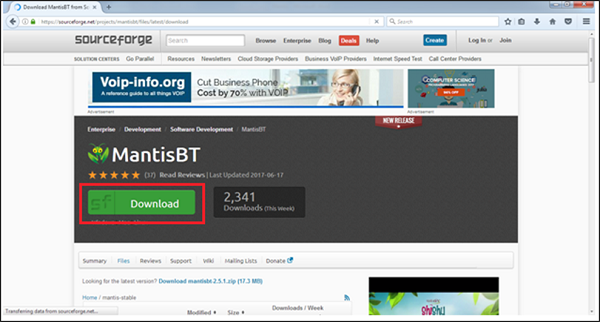
Step 4−インストールされているXAMPPフォルダーに移動し、htdocsフォルダーに移動します。ダウンロードしたカマキリを解凍し、次のスクリーンショットに示すように配置します。

Step 5 − URLを改善するために、フォルダ名mantis2.5.1の名前をmantisに変更します。
Step 6 −ブラウザを開いて、次のように入力します http://localhost/mantisナビゲーションバーでEnterキーを押します。次のスクリーンショットに示すように、カマキリのインデックスが表示されます。mantis-2.5.1をクリックします。

次のスクリーンショットに示すように、インストール前のページが表示されます。

Step 7−必要に応じて、[インストール]セクションに移動し、変更を加えます。次に、[データベースのインストール/アップグレード]ボタンをクリックします。

インストールが完了すると、[インストールの確認]ページが表示され、[正常]とマークされます。つまり、Mantisが正しくインストールされています。
Step 8 −カマキリを起動するには、URLを使用します http://localhost/mantis and click mantis-2.5.1。次のスクリーンショットに示すように、Mantisのログインページが表示されます。
Note − URLを使用する前に、Webサーバーとデータベースの両方が実行されていることを確認してください。実行されていない場合、問題の読み込みページエラーが表示されます。
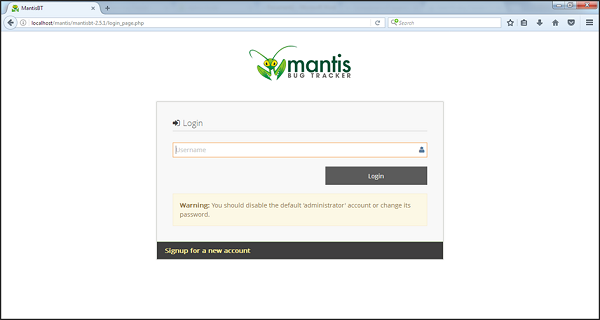
Step 9−ユーザー名を「管理者」として入力し、[ログイン]をクリックします。パスワードの入力を求められます。パスワードとして「root」を使用し、「ログイン」をクリックします。

ログインに成功すると、Mantisのダッシュボードが表示されます。
Mantisはオープンソースツールです。ただし、Mantisは、ユーザーがツールをダウンロードする前に実際に体験できるデモバージョンとホスティングバージョンをサポートしています。
デモトライアルのセットアップ
デモトライアルを設定する手順は次のとおりです。
Step 1 −に移動 https://www.mantisbt.org/ 次のスクリーンショットに示すように、[デモ]をクリックします。

Step 2 −次のページで、[無料トライアルの開始]をクリックします。

Step 3 −次のスクリーンショットに示すように、サインアップページにすべての詳細を入力し、[サインアップ]ボタンをクリックします。
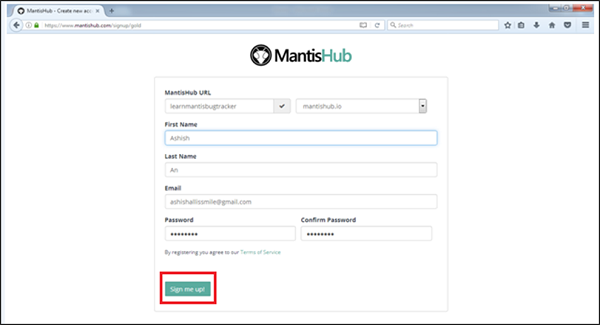
URLの設定と30日間の無料トライアルには1〜2分かかります。セットアップが正常に完了すると、ユーザーはMantisのダッシュボード/マイビューページを表示できるようになります。
次のスクリーンショットは、Mantisのマイビューページを示しています。
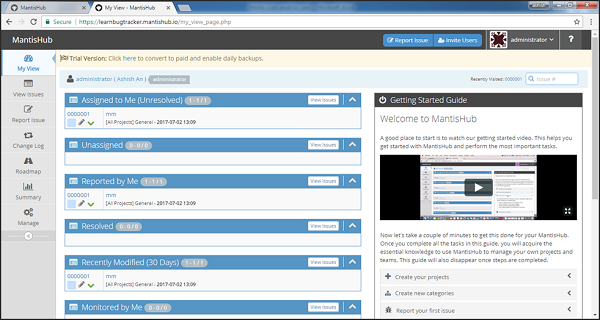
Step 1− Mantisにログインするには、サンプルのデモWebサイトにアクセスしてください。ログインページが開きます。
Step 2 −登録したメールアドレス/ユーザー名を入力し、[ログイン]をクリックします。

Step 3−ユーザー名の検証が成功すると、パスワードを要求されます。パスワードを入力し、[ログイン]ボタンをクリックします。
次のスクリーンショットは、資格情報を使用してMantisにログインする方法を示しています。
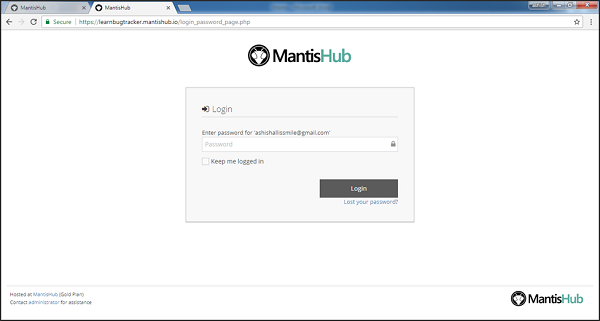
エラー時
ログインに失敗したため、エラーページが表示され、ユーザーはユーザー名ページに戻ります。次のスクリーンショットは、パスワードが正しくない場合にユーザーが受け取るエラーメッセージを示しています。

[パスワードを紛失しましたか?]をクリックします。

パスワードリセットリンクを取得するには、ユーザー名とメールアドレスを入力してください。次のスクリーンショットに示すように、[送信]をクリックします。

ユーザーには、パスワードをリセットするためのURLが記載されたメールが届きます。
ログイン成功時
ログインに成功すると、システムダッシュボードに、アカウントが管理者によってプロジェクトに関連付けられているか、ユーザーがサンプルプロジェクトを作成できるかが表示されます。これについては、以降の章で説明します。
次のスクリーンショットは、ログインに成功したときのMantisのダッシュボード/マイビューページを示しています。

Mantisにログインした後、表示される最初のページはMyViewです。マイビューは管理者によってカスタマイズされます。管理者は、役割に基づいて、Mantisへのアクセスを設定できます。管理者は、ロゴ、名前、および情報へのアクセスを役割/個人ベースで変更する権利もあります。
Mantisページの上部にあるナビゲーションバーは、Mantisのすべてのページ/画面で同じになります。ナビゲーションバーのメインリンクは、[問題の報告]、[ユーザーの招待]、[管理者]、および[ヘルプ]です。
メニューバーにはいくつかのセクションがあります(左側の上から下)。これらのセクションはMantisの心臓部であり、すべての主要な機能をカバーしています。メニューバーには、[マイビュー]、[問題の表示]、[問題のレポート]、[変更ログ]、[ロードマップ]、[概要]、および[管理]のセクションがあります。
メニューバーの横からナビゲーションバーまで、メインの情報セクションは[マイビュー]ページに属しています。このセクションを除いて、ページの他のすべての部分は静的であり、すべてのページで同じままです。
左側(メニューバーの後)で、ユーザーは、[自分に割り当て済み]、[未割り当て]、[自分で報告]、[解決済み]、[最近変更した]、[自分で監視]などのさまざまなセクションでログに記録された問題を表示できます。
ユーザーは、問題IDと名前をクリックして、特定の問題に移動できます。
ページの右側に、ユーザーはスタートガイドを見ることができます。ここでは、新規ユーザーはMantisから始めるための基本的な機能について学ぶことができます。プロジェクト構造を維持する方法についてユーザーに慣れるための数分のチュートリアルがあります。
次のスクリーンショットは、Mantisのマイビューページの概要を示しています。

[はじめに]セクションの下に、タイムラインという別のセクション名があります。
ここで、ユーザーは、誰が問題を作成したか、いくつの問題が作成されたか、誰が最近どの問題を選択したかなど、1週間または特定のタイムラインで実行されたアクティビティを確認できます。
次のスクリーンショットは、マイビューページのタイムラインセクションを示しています。

プロジェクト管理アクティビティを実行するには、ユーザーに管理者権限が必要です。
プロジェクトを作成する
プロジェクトを作成する手順は次のとおりです。
Step 1 −管理者としてログインします。
Step 2 −左側のメニューバーにある「管理」セクションに移動します。
Step 3 −「プロジェクトの管理」タブをクリックします。
Step 4−新しいプロジェクトを作成するには、[新しいプロジェクトの作成]ボタンをクリックします。既存のプロジェクトを編集するには、プロジェクト名をクリックします。ここで、「マイプロジェクト」は既存のデフォルトプロジェクトです。
次のスクリーンショットは、新しいプロジェクトを作成する方法を示しています。

Step 5 − [プロジェクトの作成/プロジェクト名]をクリックすると、[プロジェクトの作成]フォームが開きます。
Step 6 −作成前に以下のフィールドに入力してください−
Name −プロジェクト名を入力します。
Description −プロジェクトの簡単な説明または要約。
Status−プロジェクトの成熟度または開発状況。これは情報フィールドであり、Mantisには影響しません。
View Status−パブリックプロジェクトの場合、ログインしているすべてのユーザーがプロジェクトを表示できるかどうか、プロジェクトにアクセスできるユーザーを決定します。プライベートプロジェクトは、プロジェクトに割り当てられたユーザーまたは管理者にのみ表示されます。
Step 7 −次に、[プロジェクトの追加]ボタンをクリックします。
次のスクリーンショットは、新しいプロジェクトを追加/更新するために入力/編集するフィールドを示しています。

プロジェクトが正常に作成されると、次のスクリーンショットに示すように、ユーザーはプロジェクトセクションに新しいエントリを表示できます。
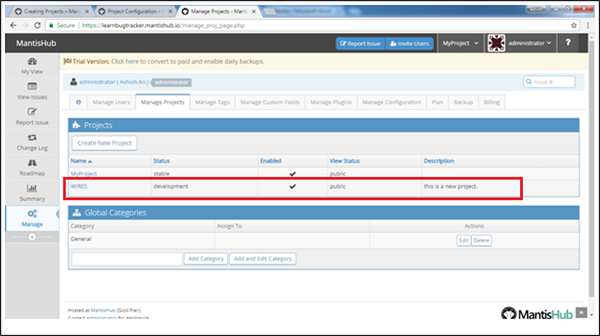
プロジェクトを選択する
プロジェクトを選択するには、ページの右上隅にあるナビゲーション機能を使用できます。このオプションを表示するには、ユーザーは少なくとも2つのプロジェクトを表示する資格が必要です。ユーザーが表示する資格のあるプロジェクトは、「すべてのプロジェクト」オプションの下に一覧表示されます。
ユーザーがリストから[すべてのプロジェクト]オプションを選択すると、ユーザーが表示する資格のあるリストされたすべてのプロジェクトが表示されます。
個々のプロジェクトを表示するには、ユーザーはリストから特定のプロジェクトを選択する必要があります。
次のスクリーンショットは、プロジェクトを選択する方法を示しています。

プロジェクトをアーカイブする
ユーザーが利用可能なプロジェクトのリストからプロジェクトを非表示にしたい場合は、上部のドロップダウンリストから、プロジェクトをアーカイブすることがその解決策です。
プロジェクトがアーカイブされると、ユーザーはそれぞれのプロジェクトの問題を表示できなくなります。
要件に基づいて、プロジェクトをアーカイブ解除することもできます。
Step 1 − [管理]→[プロジェクトの管理]に移動します。
Step 2 −アーカイブ/アーカイブ解除が必要なプロジェクト名をクリックします。
Step 3 −アーカイブ解除/アーカイブの有効化フィールドにチェックマークを付けます。
Step 4 − [プロジェクトの更新]をクリックします。
次のスクリーンショットは、プロジェクトをアーカイブ/アーカイブ解除する方法を示しています。
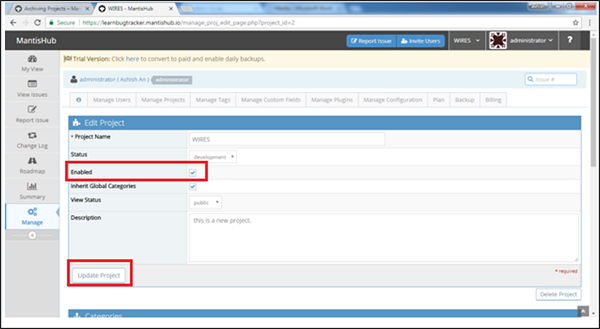
プロジェクトの作成後、ユーザーはカテゴリを分類する必要があります。カテゴリを使用すると、問題を「ユーザーインターフェイス」、「バックエンド」、「データベース」、「サービス」などのさまざまな領域に分割できます。これは、問題の種類、ソフトウェアの機能領域、またはさまざまな開発の専門知識に基づいています。チーム。
ユーザーは、プロジェクトに固有のカテゴリを作成することも、すべてのプロジェクトにわたってグローバルに定義することもできます。Mantisは、「一般」と呼ばれる事前定義されたグローバルカテゴリをサポートしています。これは、プロジェクト間で問題を移動するときにデフォルトのカテゴリとして使用され、ターゲットプロジェクトにはソースカテゴリがありません。
カテゴリを作成する
Step 1 − [管理]→[プロジェクトの管理]タブに移動します。
Step 2 −テキストボックスにカテゴリ名を入力し、[カテゴリの追加]をクリックします。
次のスクリーンショットは、グローバルカテゴリを追加する方法を示しています。

追加が成功すると、ユーザーは[グローバルカテゴリ]セクションでカテゴリ名を確認できるようになります。ユーザーは、[アクション]列の下にある[編集]ボタンをクリックして、いつでもカテゴリを編集できます。
次のスクリーンショットは、追加されたカテゴリと[編集]ボタンを示しています。

カテゴリを構成する
カテゴリは、デフォルトの担当者に設定できます。
このカテゴリで記録されたすべての問題は、チームメンバーに自動的に割り当てられます。
Step 1 −カテゴリを設定するには、[管理]→[プロジェクトの管理]→[グローバルカテゴリ]に移動します
Step 2 −前のスクリーンショットに示すように、[編集]をクリックして特定のカテゴリを構成します。
Step 3 − [プロジェクトカテゴリの編集]で、ドロップダウンリストから[割り当て先]を選択します。
Step 4 − [カテゴリの更新]をクリックします。
ここで、ユーザーはカテゴリ名も編集できます。
次のスクリーンショットは、カテゴリを構成する方法を示しています。

カテゴリを削除する
Step 1 −カテゴリを削除するには、[管理]→[プロジェクトの管理]に移動します。
Step 2−削除する特定のカテゴリをクリックします。次に、次のスクリーンショットに示すように、[アクション]列から[削除]ボタンをクリックします。

Step 3− [削除]をクリックすると、Mantisは警告メッセージを表示し、ユーザーが特定のカテゴリを削除するかどうかの確認を求めます。次のスクリーンショットに示すように、[カテゴリの削除]ボタンをクリックします。

削除されたカテゴリの下に問題がリストされている場合、削除後、問題は自動的に更新され、カテゴリなしとして表示されます。
ユーザーは手動で問題をフィルタリングし、それらのカテゴリを更新できます。
バージョンはリリースとも呼ばれます。これらは、問題を達成/解決するための一連の目標です。これらはバージョンで維持できます。
プロジェクトの更新と開発は、いくつかのリリースまたはバージョンに編成されています。バージョンには、1.0、1.1という名前を付けることも、「20171020」という機能のリリース日に基づくこともできます。
バージョンは、問題のすべてのバージョン関連フィールドに使用されます。プロジェクトにバージョンがある場合にのみ、バージョンが問題に表示されます。この機能を利用するには、ユーザーはプロジェクトにバージョンを作成する必要があります。
発行フォームには、バージョンに関連する3つのフィールド(製品バージョン、ターゲットバージョン、および修正済みバージョン)があります。
Product Version 問題が発見され、ユーザーによってログに記録されたバージョンのメモ。
Target Versionは、問題の修正が予定されているバージョンを表示する将来または現在のバージョンです。これにより、プロジェクトのロードマップが自動的に作成されます。
Fixed-in Version問題が実際に修正または実装されたバージョンを示します。これにより、プロジェクトの変更ログが自動的に入力されます。
バージョンの更新または追加
Step 1 −プロジェクトのバージョンを追加または更新するには、[管理]→[プロジェクトの管理]タブに移動します。
Step 2 −バージョンを追加する必要があるプロジェクト名をクリックします。
Step 3 − [バージョン]セクションまで下にスクロールします。
次のスクリーンショットは、バージョンに移動する方法を示しています。

次のスクリーンショットは、バージョン名を入力して[バージョンの追加]をクリックしてバージョンを追加する方法を示しています。

Step 4 −バージョンを更新するには、上記のように[編集]ボタンをクリックします。
Step 5−ユーザーは、要件に基づいてすべてのフィールドを更新できます。次のスクリーンショットに示すように、[バージョンの更新]をクリックします。

ライフサイクルは、問題のさまざまな段階またはステータスを示します。ライフサイクルは、問題の報告から始まり、問題が解決またはクローズされたときに終了します。問題には主に、オープン、解決、クローズの3つの段階があります。ただし、さらに説明するように、Mantisはより多くのステータスをサポートします。
ステータス
New−これは、ユーザーが報告したときの新しい問題の最初のステータスです。次のステータスは、「フィードバック」、「確認済み」、「確認済み」、「割り当て済み」、「解決済み」のいずれかです。
Feedback−このステータスは、レビューの目的で使用されます。チームメンバーに割り当てる前に、レビュープロセスが発生して、問題および懸念チームの有効性が決定されます。次のステータスは、「新規」、「割り当て済み」、または「解決済み」の場合があります。
Acknowledged−このステータスは、開発チームが問題の受信に関する確認を送信したり、レポーターの懸念に同意したりするために使用されます。ただし、まだ問題を再現していない可能性があります。次のステータスは「割り当て済み」または「確認済み」です。
Confirmed−このステータスは通常、開発チームが問題を確認して再現したことを反映するために使用されます。次のステータスは「割り当て済み」です。
Assigned−このステータスは、問題がチームメンバーの1人に割り当てられており、チームメンバーが問題を修正して積極的に取り組んでいることを反映するために使用されます。次のステータスは「解決済み」です。
Resolved−このステータスは、問題が修正または解決されたことを反映するために使用されます。問題は、次のいずれかの解決策の中で解決できます。たとえば、問題は、「修正済み」、「重複」、「修正されない」、「変更は不要」、またはその他の理由で解決済みと呼ばれる場合があります。次のステータスは「クローズ」です。問題が再度開かれている場合は、「フィードバック」になります。
Closed−このステータスは、問題がクローズされ、正常に検証されたことを反映しています。それ以上のアクションは必要ありません。問題がクローズされると、[問題の表示]ページから問題が非表示になります。
プロジェクトとカテゴリが定義されると、ユーザーはさまざまなカテゴリのプロジェクトに対して問題を報告して、進行状況を追跡できます。
問題を報告する手順は次のとおりです-
Step 1 −ユーザーが複数のプロジェクトにアクセスできる場合は、最初に画面の右上隅にあるプロジェクトを選択します。ここで問題が報告されます。
レポートの問題フォームに進むには2つの方法があります-
Step 2 −プロジェクトフィルターの横にある上部にある[問題の報告]リンクをクリックするか、左側のメニューバーから[問題の報告]セクションをクリックします。
次のスクリーンショットは、プロジェクトフィルターとレポートの問題で使用可能なオプションを設定する方法を示しています。

Step 3 − [問題の報告]をクリックすると、必須フィールドとオプションフィールドを含む[問題の詳細の入力]ページが開きます。
Step 4−すべての詳細を正しく入力してください。これらは次のフィールドです-
Category −関係するチームが調査を開始できるように、開発、データベース、サービスなど、プロジェクトのどの領域に属するかを定義します。
Summary −問題に関する高レベルの情報を提供する問題の簡単なタイトル。
Description−問題の詳細情報。マイナーからメジャーまでのすべての関連する詳細が含まれている必要があるため、関係するチームメンバーがすべての側面を分析します。
必須フィールドに加えて、設定の重大度、優先度、タグ、ビューステータスなどの便利なオプションフィールドがあります。
ユーザーは、それを特定のユーザーに割り当てたり、ファイルを添付ファイルとしてアップロードしたりすることもできます。
Step 5 −ユーザーが複数の問題を報告する場合は、[レポート滞在]チェックボックスをオンにします。これにより、問題の送信後に問題のレポートページに戻ります。
Step 6 −次に、ページの下部にある[問題の送信]ボタンをクリックします。
次のスクリーンショットは、さまざまなフィールドと[送信]ボタンを示しています。


Step 7 −作成が成功すると、ユーザーは[問題の表示]ページに移動します。このページでは、新しく報告された問題を確認できます。

ユーザーは、CSVファイルを使用して一度に複数の問題を作成できます。CSVファイルはカンマ区切りファイルです。
CSVファイルのルール
CSVファイルを作成する際には、以下の点を考慮する必要があります-
CSVファイルはプロジェクトごとに個別にする必要があります。
CSVファイルはCSV(カンマ区切り)として保存する必要があります。
ユーザーは、CSVインポート手順を開始する前にプロジェクトに切り替える必要があります。
すべてのエントリは、ノートブックアプリケーションで作成する必要があります。各エントリは、コンマ「、」で区切る必要があります。
Files should be saved as filename.csv and the file type as All files.
Don’t map ID field with any field in CSV. The system will automatically generate an Issue ID.
For multiple lines “\n” can be used.
For timestamp fields such as issue submission and last update timestamps, it is recommended using ISO 8601. However, PHP accepts any method strtotime (). If an integer is provided as the value, then it will be treated as the number of seconds, since Unix Epoch (January 1 1970 00:00:00 GMT).
Sample file will look like the following −
| login | wires | General | login functionality should be available | Assigned to | administrator | 1.0 |
| error | wires | General | error message on wrong credential | new | 1.0 | |
| on successful | wires | General | welcome page on successful login | Assigned to | administrator | 1.0 |
Import CSV
To import a CSV file, the user should perform the following steps −
Step 1 − Go to Manage → Manage Plug-in.
Step 2 − Check whether the CSV Importer plug-in is installed or not.
Step 3 − If it is not installed, click Install as shown in the following screenshot.

Step 4 − Since CSV Importer is not present in the Installed Plugins, go to Available Plugins section and find CSV Importer. Click Install as shown in the following screenshot.
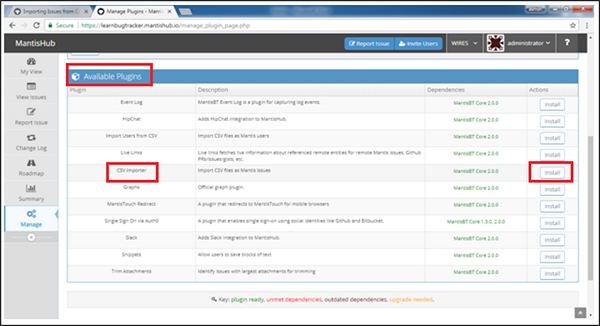
Step 5 − After installation, the user can see CSV Importer in the Installed Plug-in section. The Import CSV File section is also present. Click Import CSV File as shown in the following screenshot.

Step 6 − After clicking Import CSV file, import issues from the CSV file opens. Select various options based on the file and requirements as shown in the following screenshot. Later, click Choose File to browse the file and then click Upload file.
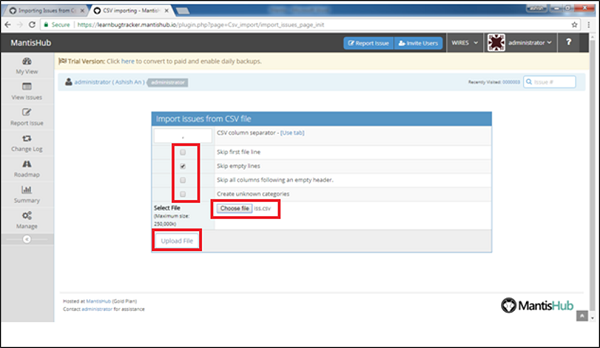
Step 7 − After successful upload, the user can see the data column wise. Below that, the user needs to map those columns with different fields of Issue form as shown in the following screenshot.
Step 8 − After mapping, click the Import File button.

After completion of import, the user can see counts of successful and unsuccessful entries.

Automatically, the user navigates to View Issues tab at Viewing Issues section as shown in the following screenshot.

In the View Issues section, the user can view all the reported bugs for a project. The user can filter out to narrow down the search and export all issues and print reports. All of the major functionalities of Issues can be accessed through View Issues.
We will discuss all of these functionalities in different chapters. In this chapter, we will discuss about Filters, Export and Print Reports.
Filters
To use filters in View Issues, following steps should be performed −
Step 1 − Click View Issues from the left Menu.
In the first half, the filter section displays where the user can set various filters.
Step 2 − To set a filter, click Field name. For example: Reporter in this case. It will display the available dropdown list to select.
Step 3 − After the selection of other filters as well, click Apply Filter to search the result as shown in the following screenshot.

Step 4 − After clicking the Apply Filter button, Issues are displayed at the bottom of the screen in the Viewing Issues section as shown in the following screenshot.

Step 5 − By clicking the Save Current Filter, the user can save the filter and use whenever required.

Step 6 − After clicking the Save Current Filter button, the following form opens to enter Filter Name. Enter the name and check Make Public, Apply for all projects. Click Save Current Filter.

Step 7 − A dropdown will display beside the Save Filter button where the user can see currently saved filter name and select the filter from there. This dropdown list displays all available filter list as shown in the following screenshot.

Print Reports
In View Issues → Viewing Issue section, the user can print the records and basic details of issues. After filtering out the issues, the user can print these in different formats.
To Print the Reports, following steps should be performed −
Step 1 − Go to View Issues from the Menu, set the filters, and click Apply Filters.
Step 2 − Now, go to Viewing Issues section and make sure the issues are displayed.
Step 3 − Select the issues to print and click Print Reports as shown in the following screenshot.
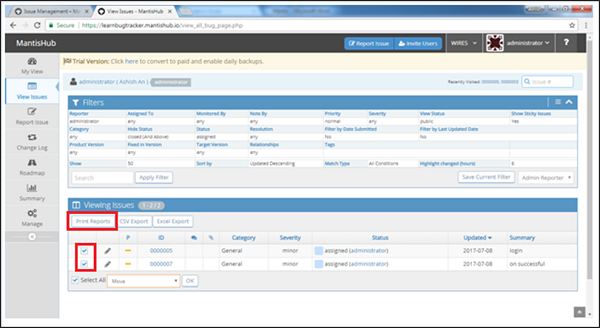
Issues are displayed as browser page and have Word and HTML (Internet Explorer) sign at the top left corner of the screen as shown in the following screenshot.
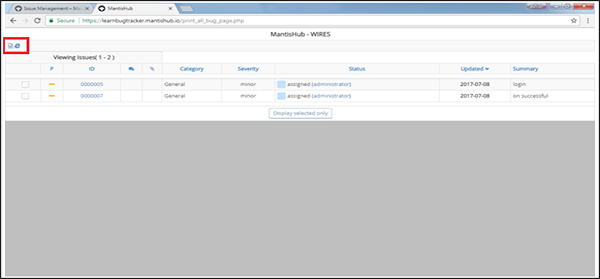
Step 4 − By clicking the Word symbol, it downloads the word file having the details of the bug. The sample word file will look like: The name of the file would be <project name>.doc and it contains complete details of each issue.

Step 5 − Click the HTML sign, a new browser opens that contains complete details of each issue as shown in the following screenshot.

CSV/Excel Export
To export as CSV/Excel file, following steps should be performed −
Step 1 − Go to View Issues from Menu, set the filters and click Apply Filters.
Step 2 − Go to Viewing Issues section at the bottom of the page and make sure the issues are displayed.
Step 3 − Select the issues to export and click CSV/Excel Export as shown in the following screenshot.

The respective files gets downloaded having the details of the bug.
The sample CSV file will look like as shown in the following screenshot.

The sample Excel file will look like as shown in the following screenshot.

Users can edit the details of an issue any time. To edit an issue, the user should open an issue from any of the available options from My View Page or View Issue page from the left menu option.
Following steps should be performed while editing an issue.
Step 1 − Open the issue in View page by clicking on Issue ID.
The user will be able to see various sections of the View Issue Details page −
- View Issue Details
- Relationship
- Users Monitoring this Issue
- Activities
- Add Note
- Issue History
The following screenshot displays all the sections in the View Issue page.
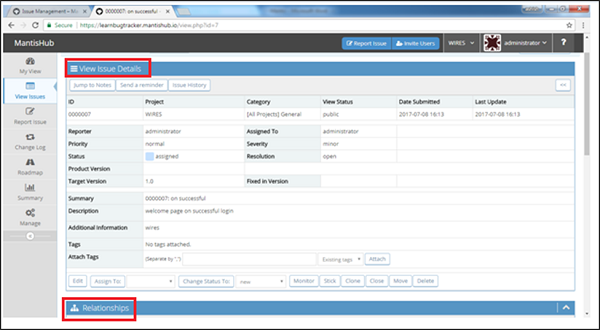

Step 2 − After opening the View Issue Details page, click the Edit button as shown in the following screenshot.

Updating Issue information page opens up showing the editable fields as depicted in the following screenshot.

Step 3 − After editing the information, click the Update Information button as shown in the following screenshot.
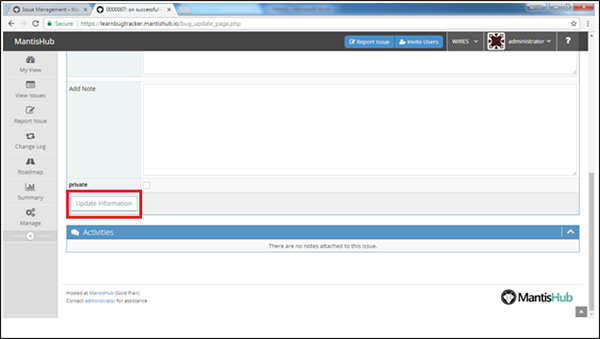
The updated information and log details can be seen in the Issue History section as seen in the following screenshot.

Cloning refers to copying. To clone an issue means to quickly create a duplicate issue within the same project. Cloned issues can be treated as a new issue and edited like other issues.
A cloned issue is a completely separate issue from the original issue. Any action or operation taken at the original issue doesn’t impact the clone issue and vice-versa. The only connection between the original and the clone is the link that is created.
Following information is carried from the original issue to the clone issue.
- Summary
- Description
- Assignee
- Environment
- Priority
- Category
- Version
- Reporter
- Target version
- Fix version
- Issue links
- Attachment
- Projects
- Content of custom fields
Following information is not cloned −
- Time tracking
- Comments
- Issue history
Following are the steps to clone an issue.
Step 1 − Open an issue in the View page by clicking the Issue ID.
Following sections of the View Issue Details page will be displayed.
- View Issue Details
- Relationship
- Users Monitoring this Issue
- Activities
- Add Note
- Issue History
Step 2 − After opening the View Issue Details page, click the Clone button as shown in the following screenshot.

It opens the report page and all available details are copied in the respective fields as shown in the following screenshot.
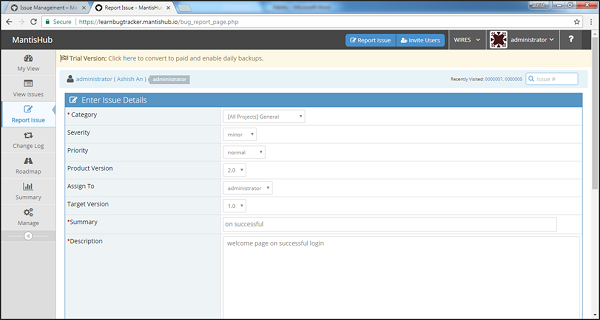
Step 3 − At the bottom of the page, the original issue id is written for the field “Relationship with the parent issue”. Select the relationship of original and cloned issue as shown in the following screenshot.
Step 4 − The section, Copy extended data from parent issue. has 2 checkboxes − Copy Issue notes and Copy attachments. Check these if you want to copy the same. By default, these are unchecked.
Step 5 − After selection, click the Submit Issue button.
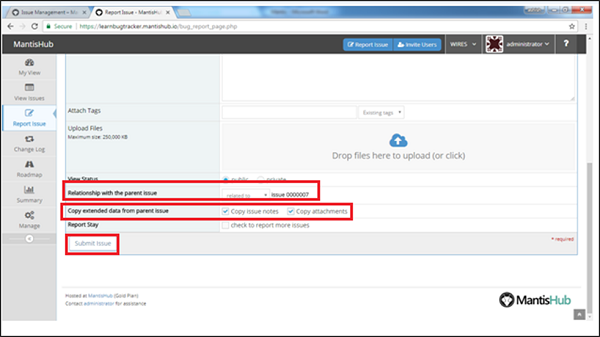
After successful submission, a new issue id generates and the view issue page opens.
While reporting an issue, along with some general information, there are advanced features supported by Mantis to make it more informational and useful. In this chapter, we will discuss about those advanced features.
@Mention - Notification
Mantis supports @mentions to gather user attentions and send notifications about an issue or note, even if they are not on the notified list.
It is a simple way to draw someone's attention. Simply reference a college in an issue note or description, and the note details with a link to the issue details will be emailed.
To mention a user in Description/Note section, first write @ and along with it write the name of user as shown in the following screenshot.
@mentions is hyperlinked to the user page and highlighted when notes/issues are formatted.

In this case, users receive both regular email notification as well as @mention notification. However, @mention notifications have a simplified format as well as a different subject.
The following screenshot displays the received email for @mention.
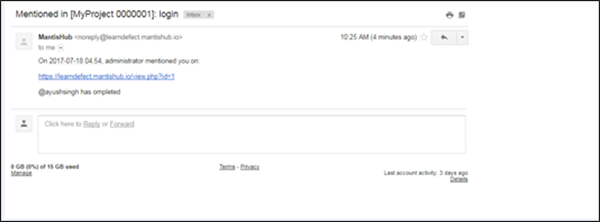
Send Reminder
Send Reminder is the alternate functionality of @mention. This feature is used to call the attention of a particular user. For example, the Product Owner sends a reminder to the team to update comments.
Mantis generally recommends to use @mention. However, it is an optional feature.
Go to the View Issue and click the Issue ID to open the View page.
At the top of the issue, the “Send a Reminder” button is displayed as shown in the following screenshot.

After clicking the Send a reminder button, a message box appears. On the left side, there is a list of users and on the right side messages can be typed. After selecting the user and writing the message, click the Send button at the bottom of the page.
The following screenshot shows how to send a reminder.
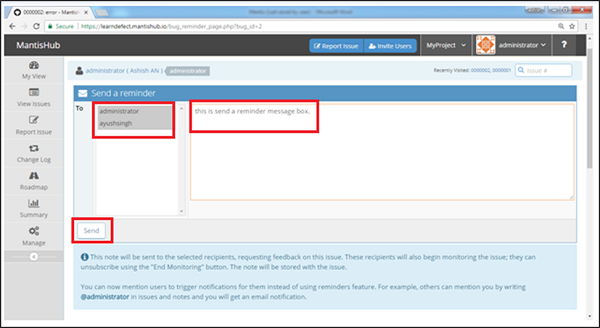
In the View Issue → Activities section, the Reminder information can be seen as shown in the following screenshot.

Text Formatting
As of now, Mantis supports the following HTML tags that can be used to format the tag in the description and notes field − p, li, ul, ol, br, pre, I, b, u, em, strong. However, Mantis doesn’t encourage formatting the text.
The text emails will have raw tags rather than formatted text. Mantis has a plan to move towards Markdown for formatting, which will deprecate HTML tags.
In addition to Markdown support, Mantis is planning to support html emails. These features together will address the limitations of the existing solution. However, as of now, there is no specific timeline for Markdown or for HTML emails support.
Attach Files
Mantis supports attaching multiple files to an issue. A user can attach the file while reporting the issue by clicking the Choose File button. The file can also be attached from the View Issue by clicking the Upload File button. Alternative method, is to attach the file in Edit Issue mode.
The following screenshot displays how to attach a file in the View Issue module.

Click the above marked button and browse the file to upload. Files will be displayed below the button on successful upload.
Then, click Add Notes. The file will be get added in the Activities section as shown in the following screenshot.

Status is the property of an issue that helps to track the progress of an issue as well as provide the actual current status of an issue.
Mantis supports the following status - New, Feedback, Acknowledged, Confirmed, Closed, and Resolved. Users can change the status of an issue based on the work done.
Following steps should be taken to change the status.
Step 1 − Go to the View issue section and click the Issue ID of the status that has to change.
Step 2 − Click the dropdown beside “Change Status to” and select one of the statuses.
Step 3 − After selection, click the button “Change Status to” present at the View Issue Details section as shown in the following screenshot.

Based on the status selection, the <Status> Issue page opens where the user can add a note, assign to and make it private if desired.
Step 4 − After that click the <Status> Issue button. For example: For feedback, the Request Feedback on Issue page opens.
The following screenshot shows the Feedback status page.

Step 5 − Click the Request Feedback button and the status of issue is changed to feedback as shown in the following screenshot.

This feature is very useful when two issues have some type of dependency on each other, such as they are duplicates or are related to each other, upstream downstream dependency as parent/child issue.
Create a Link to Another Issue
Issues can be linked together at any point of time, while reporting an issue using the View Issue or Edit Issue page.
Step 1 − Click the view issue page.
Step 2 − Navigate to Relationships section.
Step 3 − Choose the relation of the issue with the linking issue. For example: the opened issue is parent/duplicate of another issue.
Step 4 − Now, type the issue id and click the Add button as shown in the following screenshot.

After addition, you can see the linked issues in the Relationships section. It is hyperlinked hence, it is also possible to navigate to the linked issue.
You can add a relationship for multiple issues at once using the '|' character in between issue IDs.
The following screenshot displays the linked issue.

Delete a Link
Step 1 − Go to View Issue Details page that contains the link to the issue.
Step 2 − Scroll down and go to the Relationships section.
Step 3 − Click the Delete icon as shown in the following screenshot.
Step 4 − A confirmation pop-up will be displayed as shown in the following screenshot. Click the Delete button.

Mantis has a feature to move an issue from one project to another project.
One Issue At a Time
Step 1 − Go to the View Issue Details page that needs to move to another project.
Step 2 − Click Move as shown in the following screenshot.
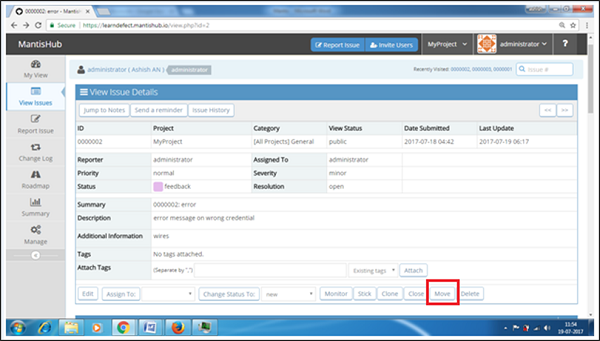
Step 3 − In the Move Issue page, select the new project where the issue will move and click the Move Issues button as shown in the following screenshot.

Multiple Issues at a Time
Step 1 − Go to the View Issue page.
Step 2 − Set the filter and navigate to the Viewing Issues section where you will find a list of issues.
Step 3 − Check the checkboxes for all issues that are required to be moved.
Step 4 − Select the Move option from the dropdown present at the bottom of the screen and then click OK.
The following screenshots display how to move multiple issues at a time.

Step 5 − In the Move Issues to page, select the new project, where the issue will move and click the Move Issue button as shown in the following screenshot.

A History is a record of all activities performed on issues such as −
- Creation of an issue
- Changes to an issue field
- Attachment of a file
- Deletion of comment/work log
- Addition/deletion of links
In a history record, the user can view the following information −
- Name of the user who made the changes
- Time while the changes was made
- If an issue field is changed, new and old values of the field
問題の履歴を表示するには、次の手順を実行します。
Step 1 −履歴を表示するには、[問題の表示]→[問題の詳細の表示(問題IDをクリックして)]ページに移動します。
Step 2 −次のスクリーンショットに示すように、[発行履歴]セクションまで下にスクロールするか、[発行履歴]ボタンをクリックします。

次のスクリーンショットに示すように、履歴レコードが表示されます。

この章で説明する問題の監視、削除、閉じる、貼り付けなど、[問題の表示]ページには他にも便利な機能があります。
モニター
Mantisには、通知を受信して問題の進行状況を監視するためのモニターと呼ばれる機能があります。問題をモニターとしてマークしたユーザーは、他のユーザーが問題に変更を加えるたびに通知されます。
問題を監視する手順は次のとおりです-
Step 1 −詳細を表示するには、[問題の表示]→[問題の詳細の表示(問題IDをクリックして)]ページに移動します。
Step 2 −次のスクリーンショットに示すように、画面の下部にある[監視]ボタンをクリックします。

ユーザーが監視を開始すると、ボタンが[監視の終了]に変わります。同じことが発行履歴からも確認できます。

Step 3 −一定期間後、監視が完了したら、上のスクリーンショットに示すように、[監視の終了]ボタンをクリックします。
ボタンが再びモニターに変わります。
スティック
MantisはStick機能をサポートしています。つまり、課題は[課題の表示]ページ→[課題の表示]セクションの最初のエントリとして表示できます。
Step 1− [問題の表示]→[問題の表示]セクションに移動し、このテーブルの最初のエントリとして表示する問題を選択します。ここでは、次のスクリーンショットに示すように、Issue ID02を選択します。

Step 2 − [問題の詳細の表示]ページの下部にある[スティック]ボタンをクリックします。

ボタン名がUnstickに変わります。
Step 3−「問題の表示」→「問題の表示」セクションに戻り、表内の問題IDの場所を確認します。次のスクリーンショットに示すように、最初のエントリとして表示されます。

Step 4 −貼り付けを解除するには、次のスクリーンショットに示すように、[問題の詳細の表示]ページに移動し、[貼り付け解除]ボタンをクリックします。

複数の問題がスティックとしてマークされている場合、それはLIFO(後入れ先出し)の概念に従います。スティックとしてマークされた最新のものが最初のエントリとして表示され、2番目に新しいエントリが続きます。
問題を閉じる
Mantisは、問題の現在のステータスから問題をクローズする機能をサポートしています。
問題を解決する手順は次のとおりです。
Step 1−「問題の表示」→「問題の表示」セクションに移動し、クローズする問題を選択します。ここでは、次のスクリーンショットに示すように、Issue ID02を選択します。

Step 2 −次のスクリーンショットに示すように、[問題の詳細の表示]ページの[閉じる]ボタンをクリックします。

Step 3−ドロップダウンから[解像度]を選択し、[メモを追加]を選択します。[問題を閉じる]ボタンをクリックします。

次のスクリーンショットに示すように、この問題では、問題のステータスが[閉じる]ではなく[再開]ボタンに変わります。

[再開]ボタンをクリックすると、いつでも問題を開くことができます。
問題を削除する
Mantisは、ユーザーが問題のいずれかを削除したい場合の削除機能をサポートしています。理由は、重複、間違った入力、または役に立たなくなった可能性があります。
問題を削除する手順は次のとおりです。
Step 1 − [課題の表示]→[課題の表示]セクションに移動し、削除する課題を選択します。
Step 2 −次のスクリーンショットに示すように、[問題の詳細の表示]ページの[削除]ボタンをクリックします。
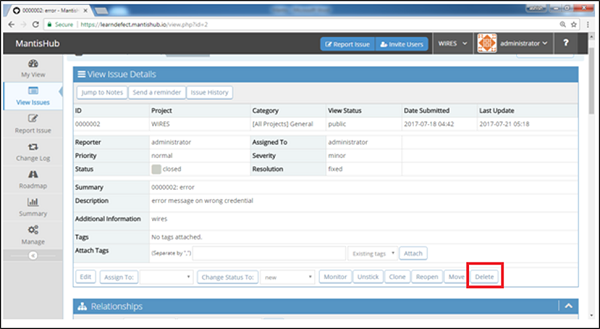
Step 3−選択した課題に対して削除アクションを実行するように求める確認ページが表示されます。次のスクリーンショットに示すように、確かに[問題の削除]ボタンをクリックします。

Mantisは基本的な検索機能をサポートしています。ユーザーは、Issue#を使用してプロジェクト全体の問題を検索できます。Mantisは、検索テキストボックスに加えて、最近アクセスした問題番号のリンクを提供しているため、ユーザーは特定の問題に直接ジャンプできます。
探す
画面の右上隅に、すべてのページにIssue#のテキストを含む検索テキストボックスがあります。
次のスクリーンショットは、検索テキストボックスの位置を示しています。

問題IDを入力し、Enterキーを押します。ワイルド検索の概念を使用して、固有の問題を見つけます。その後、次のスクリーンショットに示すように、[問題の詳細の表示]ページが開きます。

最近訪問した
[検索]テキストボックスの横に、最近アクセスした問題IDのリストがリンクとして表示された[最近アクセスした]フィールドがあります。
次のスクリーンショットは、最近アクセスしたフィールドの場所を示しています。

[問題の詳細の表示]ページを開くには、[問題の詳細]リンクをクリックします。[最近アクセスした]フィールドはすべてのページで静的であり、いつでも任意の問題にジャンプできます。
Mantisは問題をバージョンに関連付けており、この関係は変更ログで確認できます。問題の修正バージョンに基づいて、変更ログは問題を分離し、リリース/バージョン機能がカバーされている詳細を提供します。
変更ログ情報は、ソフトウェアリリース情報を含めるために使用されます。これは、ユーザーが新しいリリースの仕様を決定するのに役立ちます。「何が新しいのか」、「何が修正されたのか」などの通常の質問に答えます。および「セキュリティ修正はありますか?」
各プロジェクトには複数のバージョンがあります。ユーザーはリリースされたバージョンに対して問題を報告し、開発者は通常、今後のバージョンで問題を修正します。
問題を変更ログに記録するには、次の基準を満たす必要があります。問題は-を持っている必要があります
- 「解決済み」または「クローズ」ステータス。
- 「固定」解像度。
- バージョンは、「バージョンで修正済み」フィールドで指定する必要があります。
次のスクリーンショットは、詳細ページで満たされている上記の基準を示しています。

次のスクリーンショットは、同じ問題が[変更ログ]セクションにどのように表示されるかを示しています。画面の右上隅に、バージョンとプロジェクト名も表示されます。
[問題の表示]をクリックすると、問題の詳細が表示されます。

ロードマップページには、今後のバージョンと、これらのバージョンで修正される予定の問題に関する情報があります。これは、チーム、ユーザー、およびその他の利害関係者に提供される非常に有用な情報です。
また、問題の割り当てに優先順位を付けるのにも役立ちます。解決/クローズされた問題の数、まだ対処する必要のある問題の数など、問題の進行状況を追跡します。
問題が「ターゲットバージョン」に割り当てられると、ロードマップページに自動的にデータが入力されます。
次のスクリーンショットは、[問題の詳細]ページのどこにターゲットバージョンフィールドが存在するかを示しています。

ターゲットバージョンがIssueに追加されると、ロードマップページに表示されます。ロードマップ情報には、すべての問題の最新の進捗状況が表示されます。
ユーザーは、対処すべき問題の数、解決/解決された問題の数、および進行中の割合を確認できます。
次のスクリーンショットは、進行中のパーセンテージと問題のリストを含むロードマップページを示しています。
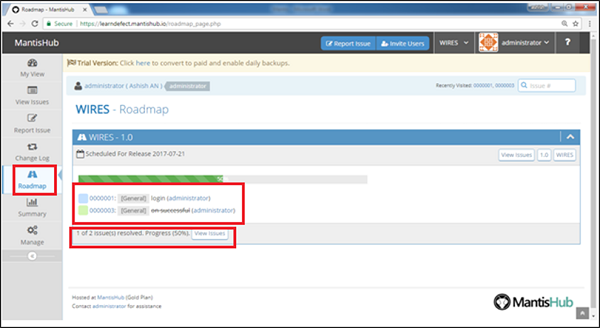
問題がターゲットバージョンに割り当てられていない場合、ロードマップには表示されません。
解決された問題は取り消し線で表示されます。
「バージョンで修正済み」フィールドが設定されている場合は、「変更ログ」ページにも表示されます。
概要ページはMantisの心臓部です。問題の表形式の記録が表示されます。Mantisは、表形式のレポートドキュメントとして[概要]ページをサポートしています。
概要ページには、次のフィールドに基づいてテーブルレコードが表示されます-
- ステータス別
- 重大度
- カテゴリ別
- 解決された問題の時間統計(日)
- 開発者ステータス
- 決議による記者
- 解像度による開発者
- 日付別
- 最もアクティブ
- 最長オープン
- 決議による
- 優先度別
- レポーターのステータス
- レポーターの有効性
各セクションには、オープン、解決済み、およびクローズのステータスにある問題の数が表示されます。また、特定のカテゴリで報告された問題の総数も表示されます。
次のスクリーンショットは、[概要]ページとそのさまざまなカテゴリを示しています。

カスタムフィールドを追加するプロセスには、最初にカスタムフィールドを定義し、次にそれを適切なプロジェクトにリンクすることが含まれます。
Step 1 − [管理]→[カスタムフィールドの管理]セクションに移動します。
Step 2 −テキストボックスにフィールド名を入力します。
Step 3 −次のスクリーンショットに示すように、[新しいカスタムフィールド]ボタンをクリックします。

Step 4 − [新しいカスタムフィールド]をクリックすると、[カスタムフィールドの編集]ページが開き、ユーザーはカスタムフィールドの仕様を定義する必要があります。
Step 5 −ドロップダウンリスト(日付、文字列、リストなど)からフィールドの「タイプ」を選択します。
カスタムフィールドタイプの場合、可能な値を書き込むことができます。使用‘|’異なる値を区切る文字。このようなリストを期待するカスタムフィールドタイプには、列挙、チェックボックス、リスト、複数選択リスト、およびラジオボタンが含まれます。
「デフォルト値」の定義により、カスタムフィールドにフィールドタイプに基づいたデフォルト値を設定できます。ほとんどの場合、これは文字列、数値、または可能な値のリストからの値などの単純な値です。ただし、日付タイプの場合、可能な値には、{今日}、{明日}、{+ 3日}、{-7日}、{来週}、{2013年12月15日}などの値を含めることができます。

Step 6 −カスタムフィールドが表示され、必須であるページを指定するチェックボックスをオンにします。
カスタムフィールドを定義したら、適切なプロジェクトにリンクする必要があります。
Step 7− [カスタムフィールドの編集]ページの一番下までスクロールして[カスタムフィールドをプロジェクトにリンク]セクションに移動します。次のスクリーンショットに示すように、表示されたリストからプロジェクトを選択し、[カスタムフィールドのリンク]をクリックします。

シーケンス番号は、カスタムフィールドの相互の相対的な順序を決定するために使用されます。小さいシーケンス番号が最初に表示されます。